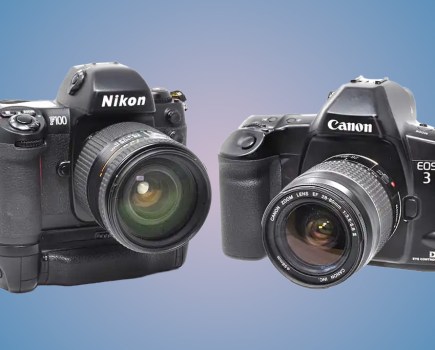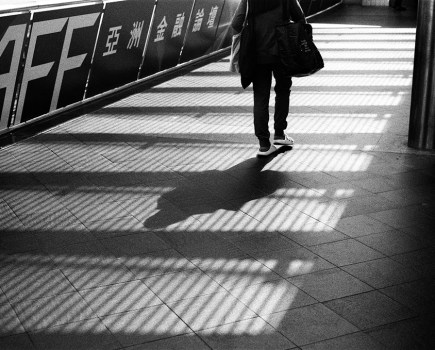A long stay in China with little to do led Millie Riley to her love of film photography, writes Damien Demolder.
Millie Riley’s camera is older than she is. In a world where most of us are worried about our cameras going out-of-date, it makes for a nice change. It makes a nice change in a world in which most of us are worried about our cameras going out-of-date and us getting behind the times. It’s a very fine camera too – an Olympus OM-2N. Somehow though I’m not sure it would have made much difference which camera 31-year-old Millie Riley had chosen from Xingguang Photographic Equipment City. Her pictures would still be really beautiful.
While some cameras are just tools, others that change the way we feel actually do have an influence on the way we shoot and I suspect Millie’s gorgeous Olympus is one of those cameras.
‘My boyfriend and I moved to China right before Covid,’ Millie says, ‘and during the pandemic I wasn’t working, so I needed something to do. I’d always quite liked photography so I decided I should take it up. I did some research into beginner cameras and liked the sound of the OM-2N as it has a good light meter. I reckoned that focusing on its own would be enough of a challenge so if the camera could take care of the metering that would be very useful.
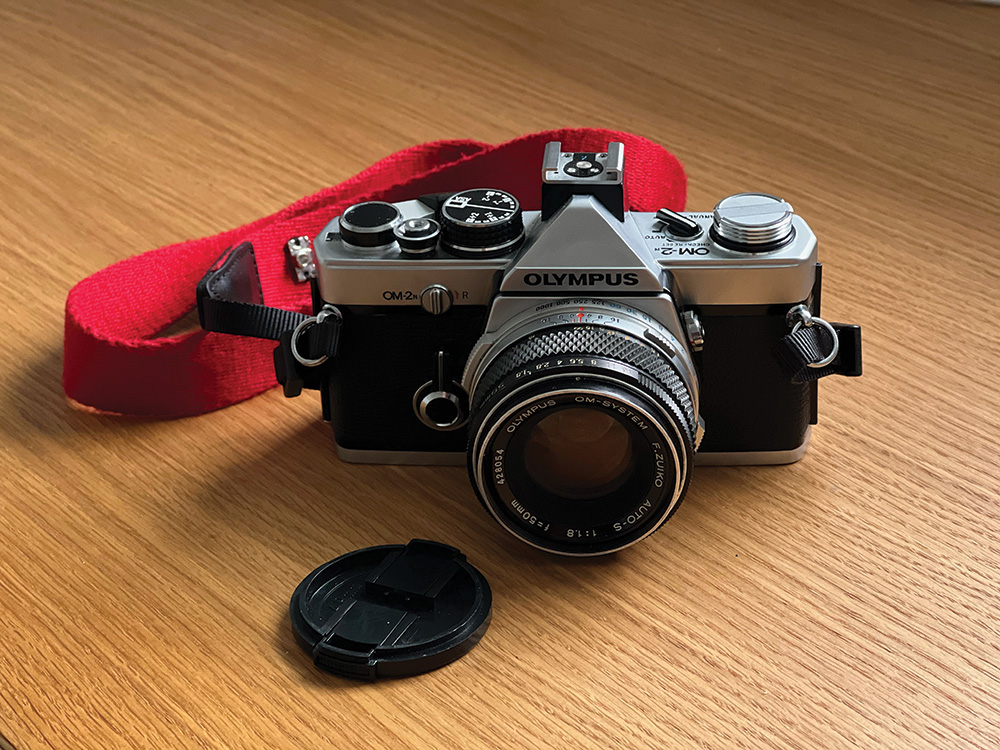
Millie’s beloved Olympus OM-2N. Photo credit: Millie Riley.
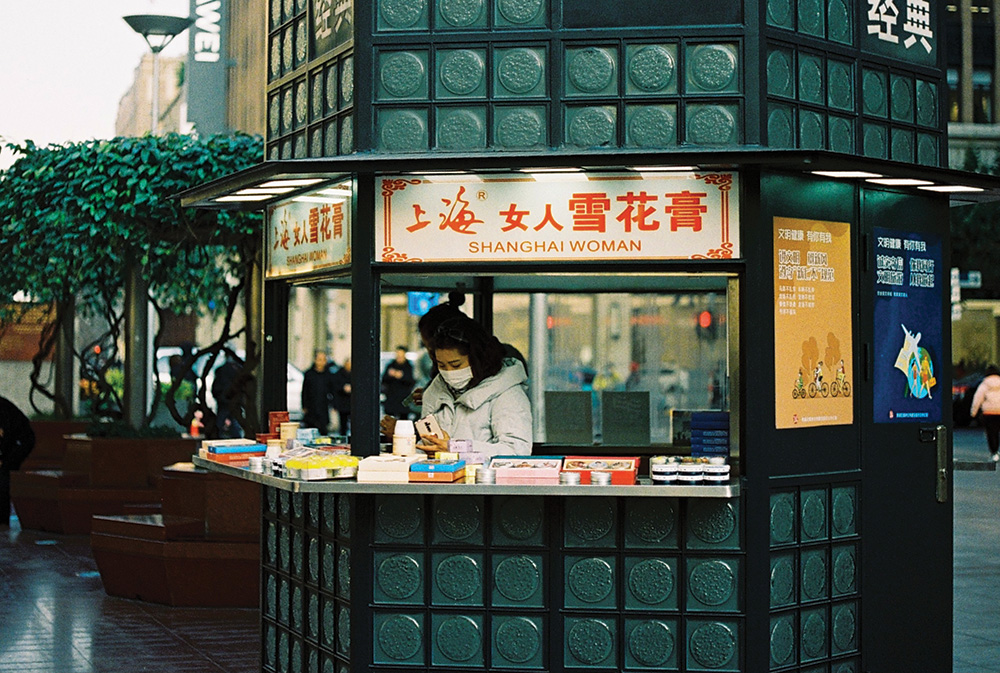
Shanghai Woman, Shanghai, December 2020. Photo credit: Millie Riley.
‘In Shanghai there’s what we’d call a shopping centre that is just camera stores. It’s five stories high! On the ground floor they have shops that sell new-fangled equipment, and the second floor is devoted to shops that sell and develop film, while other floors are for stores selling props and accessories. There’s a whole wing of four floors of shops that sell second-hand cameras, which I made my way around to figure out which cameras were legit – there are some quite dodgy ones. I’d never seen so many cameras in one place.
‘I paid about £100 for the OM-2N with a 50mm f/1.8 lens, which wasn’t cheap-cheap, but it was cheap enough. Then I went to a film shop on the floor below and bought a roll of Kodak Gold and a roll of Kodak Ultramax – which I hadn’t seen since I was a kid when my mum was into photography.’
Told in a foreign land
‘As I wandered around Shanghai taking pictures, I realised I was documenting quite a weird time for the city because there weren’t many Westerners in China during the pandemic, and no one there really knew what was going on. The locals didn’t know what was happening in the rest of China, and there was this weird disconnect between China and the rest of the world. By May 2020 life was genuinely back to normal and there was a sense that it was all over.
‘There was a lot of mask-wearing and there were still lots of health-checks for you to go about your normal day, but ultimately you were free to do as you wanted. There was a massive contrast at that time between life in China and what we were hearing from our families about was going on at home in the UK.
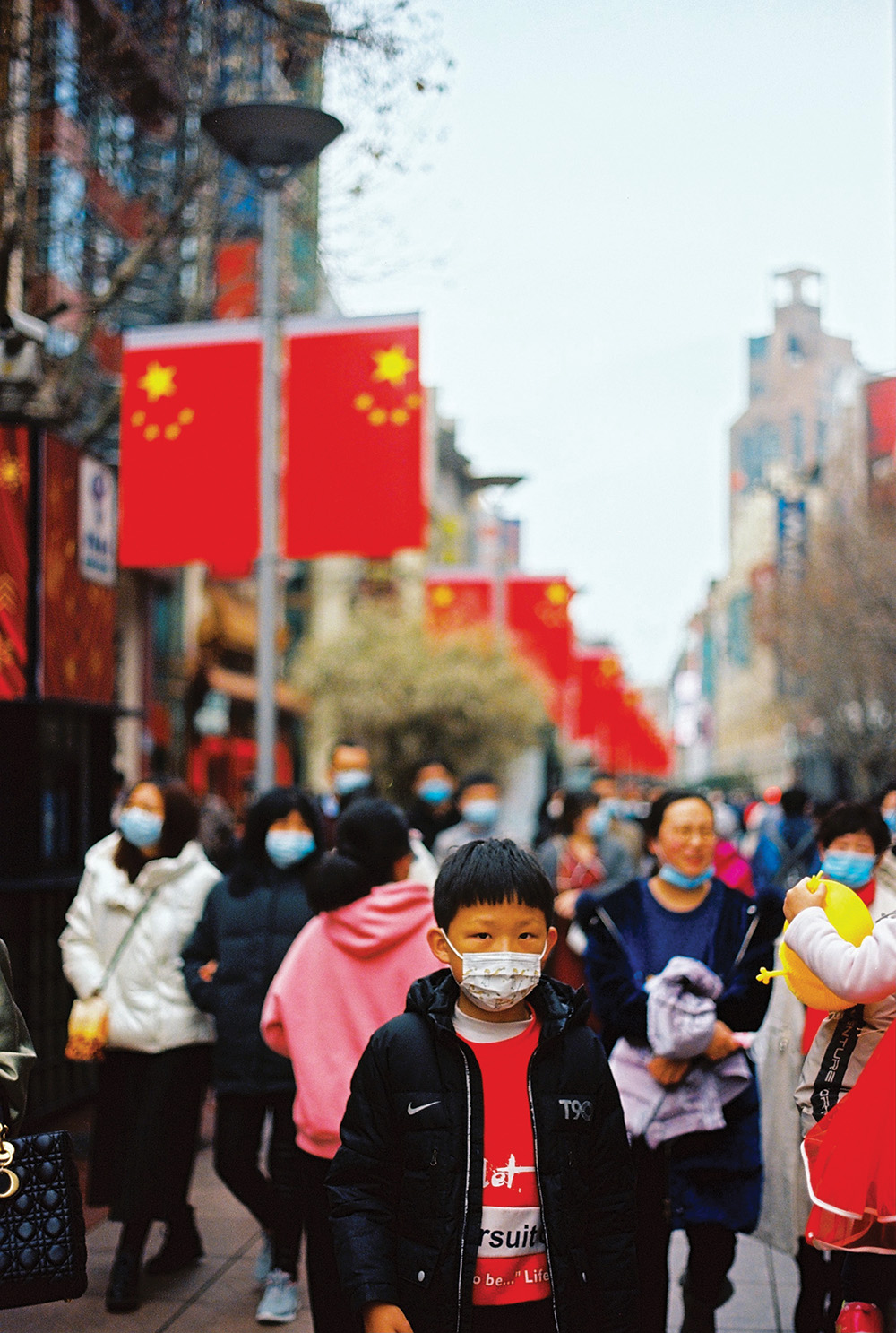
Boy on Nanjing Road, Shanghai, Chinese New Year’s Day 2021. Photo credit: Millie Riley.
‘Photography is absolutely huge in China, and whenever you go to the park there are loads of very ordinary people carrying cameras with massive lenses.
‘They set themselves up and camp all day to photograph birds. It’s not gendered, as we saw both men and women doing it. It’s a popular hobby, and a very cheap one too. Kodak Gold costs about £3 a roll, and processing is £2.50 – which is amazing. My photography has become a lot more expensive since I came home. Before we left, we stocked up on Portra 160 and brought back as much as we could.
‘Really, taking pictures in China was a way of giving myself something to do and it allowed me to explore the city without feeling totally isolated because I didn’t speak the language. It gave me a focus, and I tried to shoot as much as I could.
‘As a Westerner there was no way I could blend in, especially as there were so few foreigners there during Covid, but as photography is such an everyday activity people just understood what I was doing. I always feel it’s easier to take pictures of people abroad than when I am at home in the UK. Somehow being an outsider makes it feel less awkward and invasive. The only time I’ve had anyone have a go at me for taking their picture was in the UK, so maybe I’m just a bit paranoid.

River Cruise Ready, Guilin (Guangxi Province), January 2021. Photo credit: Millie Riley.
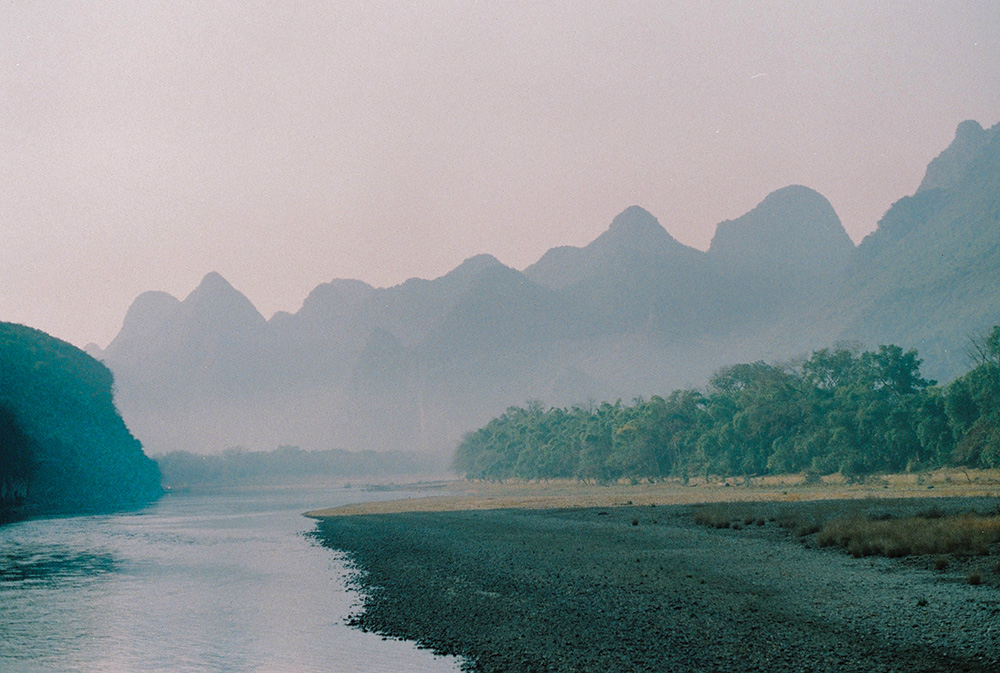
The River Li, Guangxi Province, January 2021. Photo credit: Millie Riley.
She explains: ‘I learnt how to use my camera by looking it up on the internet. I drew a diagram of the camera and labelled all the controls and took the piece of paper with the diagram around with me so I could remember what everything did. I let the light meter control the exposure so all I had to do was make sure things were in focus.
On the outcome, she says ‘I was really surprised that my first roll of film came out well, with only a couple of shots overexposed or in which I’d forgotten to focus the lens.’
Exactly what it was like
One of the things that drew me to Millie’s pictures is their lack of flashiness. I like that they are straight. They are physically straight – which is really important – but what I mean is that she isn’t trying to blind us with theatrical technique. She concentrates on showing us what it was like on that day wherever she happened to be. There’s no drama, just a straight depiction. When you see her pictures on the same page her strong individual style makes them sit very well together.
‘I like the idea of not having any drama in my pictures. I like them to be straightforward,’ she says.
‘My mum was an art teacher and enjoyed taking pictures. Her pictures from around Moss Side in Manchester were really good, and I wish I could find them. When I got the camera, she thought it was great that I was doing something arty and her first piece of advice was to just remember to get everything straight. That’s something I used to bring to mind when I first went out to try the camera. She told me to pick my spot, make sure the camera is straight and make sure I’ve focused. It was very good advice.
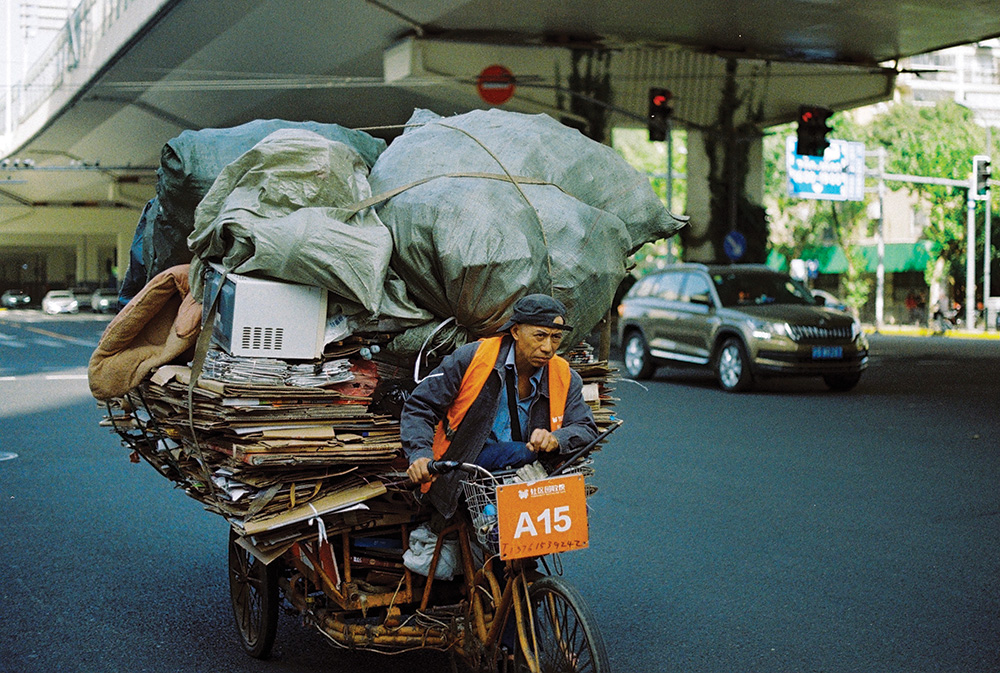
Scrap man, Shanghai, November 2020. Photo credit: Millie Riley.
‘My boyfriend also has a film camera (he saved up and bought a Leica) but we can go to the same place and come back with totally different photos, as we see things very differently. It’s amazing. He is technically better, and his pictures have a very distinct quality and more detail, but I prefer mine because they look almost like a normal person’s photos when they’ve just thought about it a bit more.
‘I don’t know if that’s the right way to put it, but I just shoot the things that interest me. That’s why my pictures flip between landscapes and people and whatever, and I don’t really think too much about it. I just shoot things I think are interesting and spend a split second thinking about how to frame the shot and perhaps noticing that what someone is wearing is noteworthy.
‘We recently went to a lovely place in West Wales on the coast that has a pretty little church. We stopped to take pictures and I was done in five minutes. My partner was crouching on the floor waiting for the perfect moment to do a long-exposure of a trickle of water, and I’d already shot the church and the beach. We are very different types of photographer.
‘I just try to take pictures of what I see and the thing that immediately catches my eye. It sounds a bit sad really, but when we go away together we don’t really talk much as we’re both thinking about what to take pictures of.’

Palermo Gentlemen, Sicily, July 2022. Photo credit: Millie Riley.
Natural observer
When faced with moving subjects Millie uses zone focusing to make sure her subjects will appear sharp. Taking a guess at where people will be when they get into the frame, she sets her manual focus lens to that distance and closes the aperture a bit to give herself enough depth of field to cover the subject should it appear in front or behind the place she expected it.
This is a technique she used when shooting in the street on a trip to Sicily. ‘Palermo is a brilliant place to take pictures,’ she says. ‘The buildings are high and the light is amazing. I just picked a spot that I liked and parked myself for five minutes to see who would come along. I saw two men crossing the road coming from a wedding, and in their suits they looked like Mafiosi.
She says, ‘I had the lens set to f/5.6 and quickly focused and hoped for the best. I can’t believe how well it came out.’
Careful composition is a key feature of Millie’s pictures. It’s clear she spends time identifying the important elements of a scene before she presses the shutter button. Standing back to make sure she gets everything comfortably in the frame doesn’t worry her either. Her work feels well-observed and intelligently seen, and honestly captured with all the right intentions.
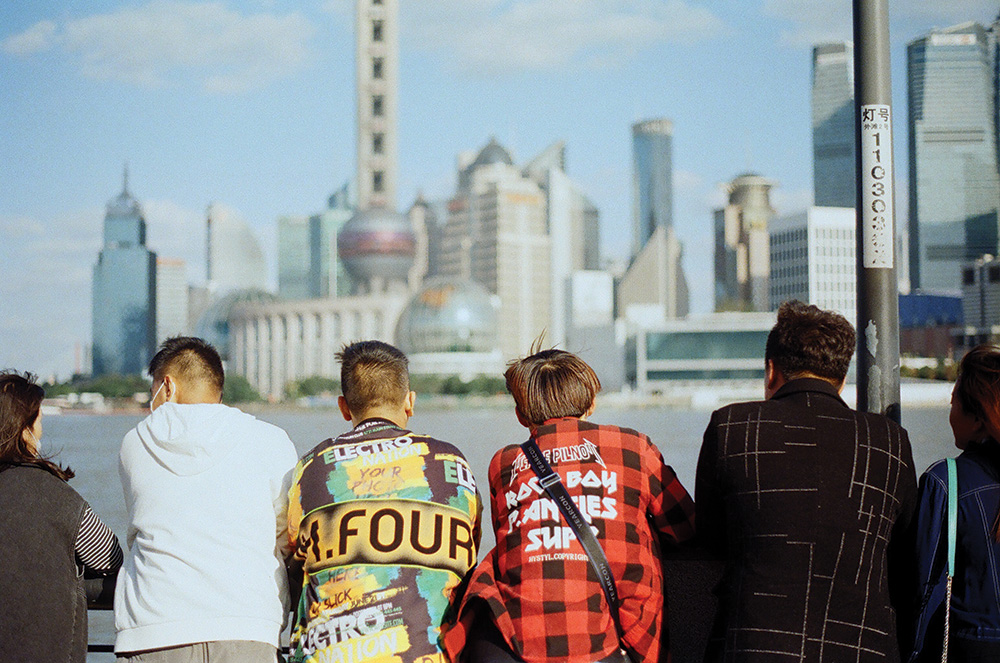
The Bund, Shanghai, November 2020 (One from the first roll of film I shot on Kodak Ultramax). Photo credit: Millie Riley.
‘I do stand back sometimes, but through a sense of not wanting to get in the way, and to try blending into the background as much as possible. People are more natural when they don’t know they are being photographed. You can tell when somebody feels conscious that you’re pointing a camera at them. Their body language changes and they kind of stiffen up a bit as they know they’re being watched.
‘There’s a thrill in observing a scene and then finding out afterwards that you included things you didn’t realise at the time. Even with photos where I’ve kind of known I’ve taken a good one I can be surprised. When I shot those guys in Palermo, I sort of knew it was a good photo but actually I hadn’t been totally conscious that they were smoking, or how their shirts were undone, which is quite funny. So you capture The Moment but you don’t really know what you’ve seen until you get the prints back.’
One-frame wonders
A good deal of Millie’s success comes from knowing when to trip the shutter. And of course, knowing when not to. Shooting film makes pictures that don’t come to anything a little more painful than when shooting with a digital camera. But even with that in mind, Millie’s hit rate is astonishingly high.
When I asked how many pictures she takes before she gets one she’s happy with, I was expecting her to say that two or three per roll was about average. ‘On a roll of 36 frames I’m usually pleased with 30 of them one way or another. That’s partly because I don’t think too deeply about it and I share almost all the pictures I take. I usually take one frame of any situation. Sometimes when the people are moving you can only get one chance, but even with static scenes I tend to only take one picture.
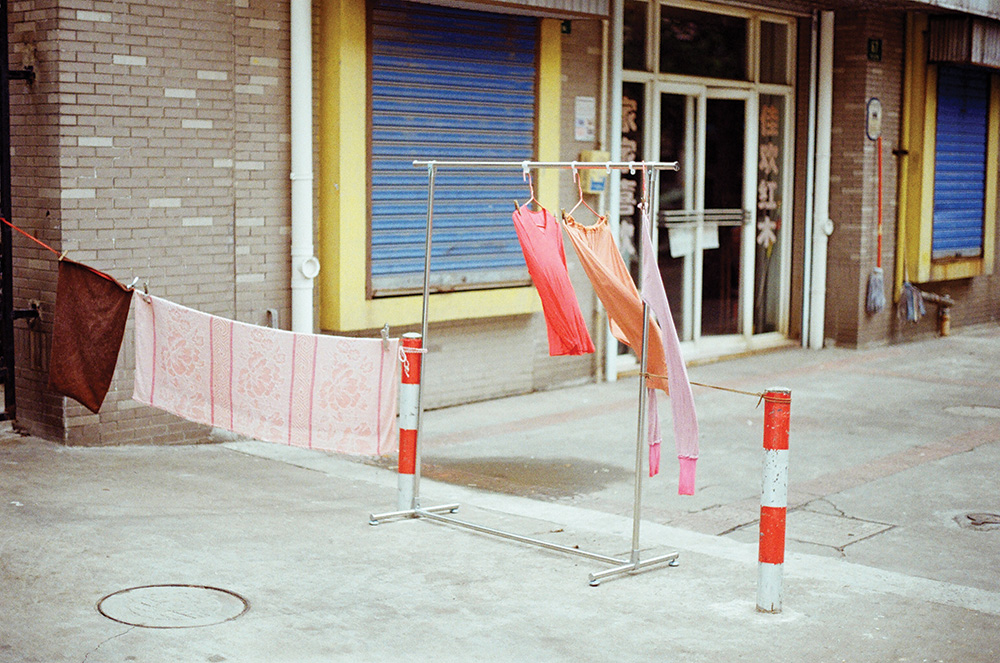
Laundry, Shanghai, November 2020. Photo credit: Millie Riley.
‘There may occasionally be duplicates, but not very often. Shooting film is expensive so I try not to shoot things I won’t like afterwards. When we went to Sicily for a week I shot four rolls of 36 exposures. Two rolls in Palermo and two when we went to see the ancient ruins. I was conscious there that each roll was going to cost me £9 to develop so I was careful. Even in China where it’s so much cheaper I only took pictures if I was sure I was going to be happy with them.
‘If I don’t like what I see, I don’t take the picture. When we went to Paris I was really excited about shooting but one day I didn’t see anything that caught my eye, so I didn’t take any pictures. I don’t know why that happened but I didn’t want to just take pictures for the sake of it.’
No more kit
‘I don’t have much desire to change my camera or to complicate things. I like the idea that I bought it in a strange shopping centre in China. If I don’t have to, I won’t ever use anything else. I have an emotional tie to it. It gave me a sense of purpose when I had nothing else to do. I’ve never had any problems with it either, and the battery is fine. I do worry that it will run out in the middle of a trip, and I should carry a spare. We’re going to Mexico next, so I’ll get a spare before we go.
‘Over time I have added another couple of lenses to the one I got with the camera, one wider and one longer. But the 50mm f/1.8 is the one I use almost all the time. It seems to frame everything perfectly and allows the subject to be prominent but still gives you room to show it in the context of its surroundings. You never feel too punched in, and it’s great at multi-tasking. You can be shooting a landscape and then turn around and take a picture of a person.
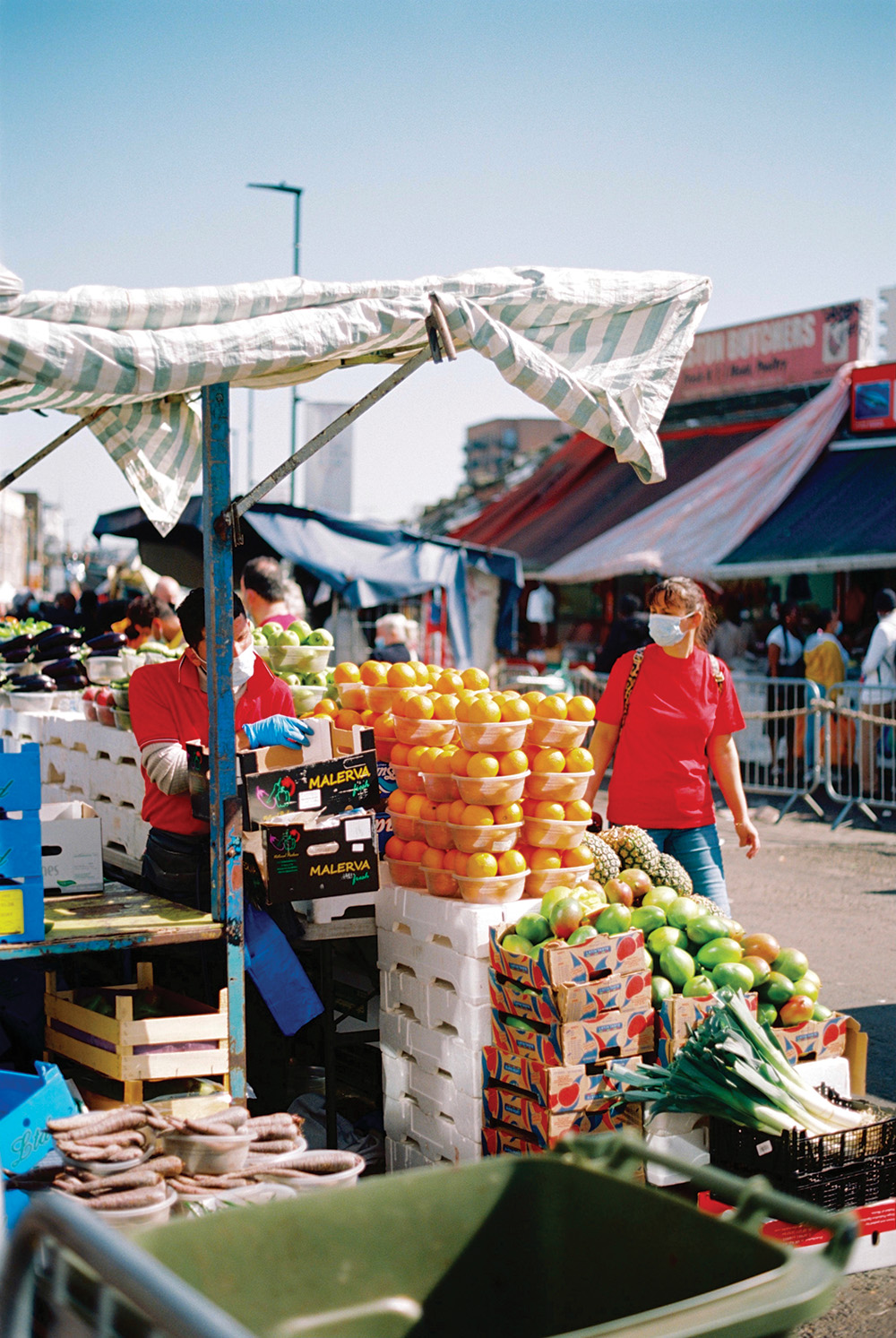
Ridley Road Market, London, March 2021. Photo credit: Millie Riley.
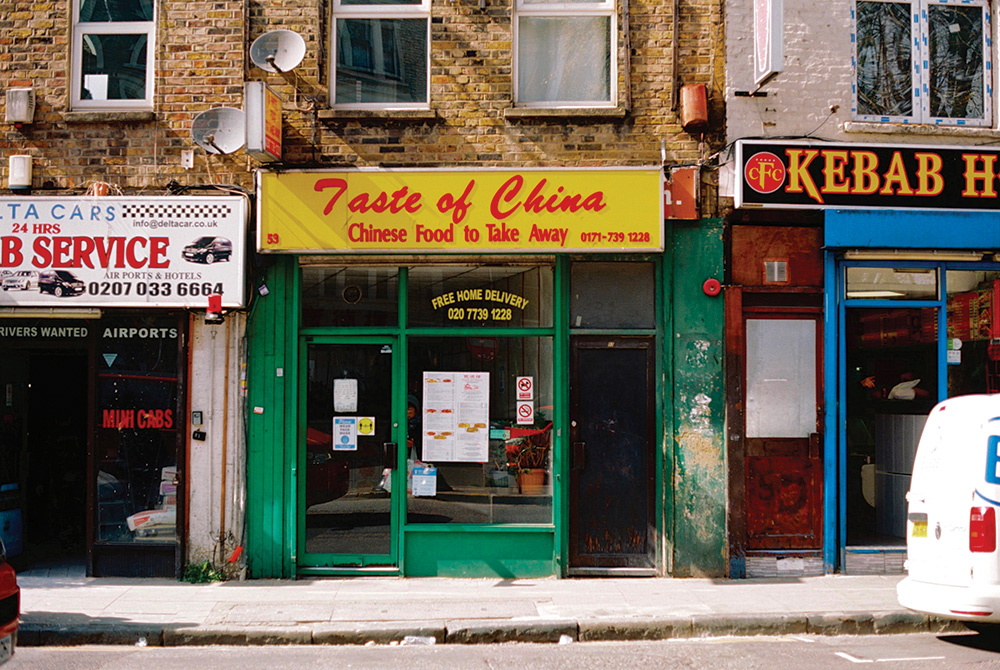
Taste of China’, London, March 2021. Photo credit: Millie Riley.
‘Whenever I have another lens on the camera I always feel that I need to change back to the 50mm. And I hate changing lenses as I’m worried I’ll miss a moment.
‘We did have a Fujifilm bridge camera before I bought the Olympus OM-2N but it seemed the pictures from my phone were just as good. Using the film camera gives me a bit more control and pictures that look very different. My phone camera is really good, but I prefer the atmosphere of the film pictures. I do still use the phone camera a lot though, and take pictures with it alongside the film camera as the GPS data in the phone pictures helps me to remember where and when each picture was taken.
She concludes, ‘I just want to keep on travelling around taking photos of things and people. I get great pleasure from the process.’
Featured image credit: Millie Riley.
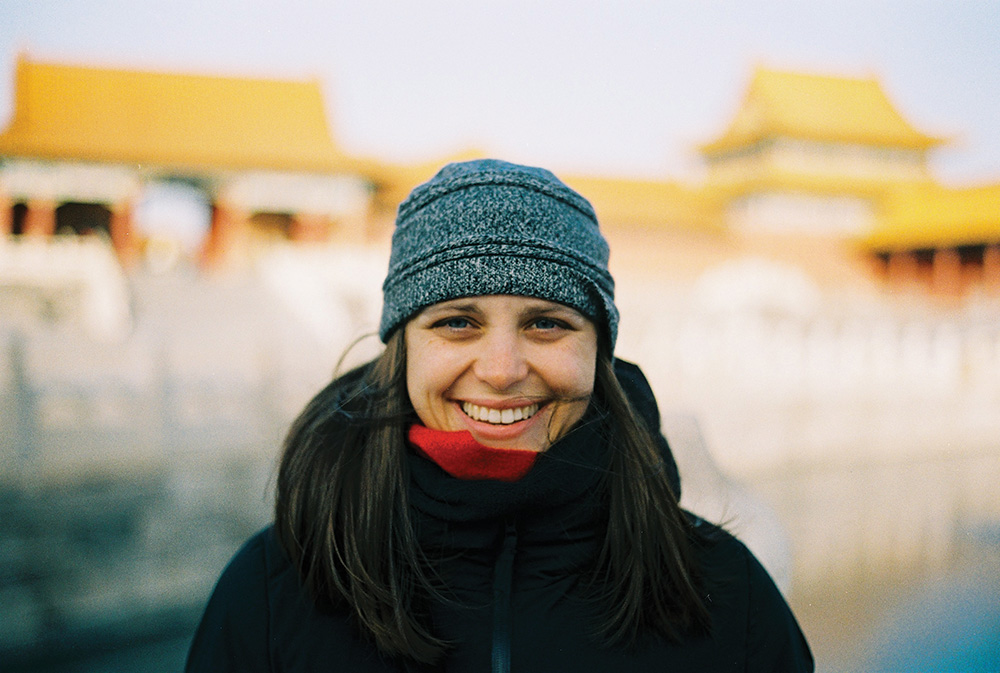
Millie in Beijing. Photo credit: Millie Riley.
You can see more of Millie’s work on her website and her Instagram account.
Related articles:
Can analogue photography be eco-friendly?
How to create outstanding travel photographs and where to visit
How to get started in film photography – a complete guide





